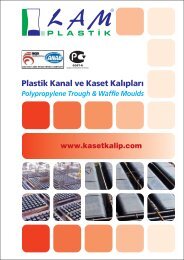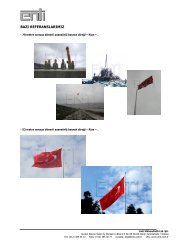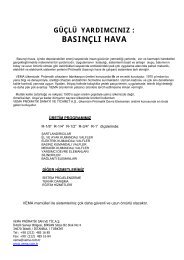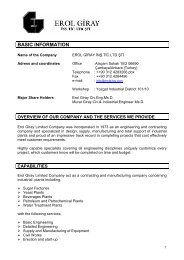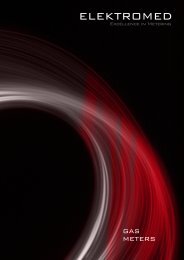You also want an ePaper? Increase the reach of your titles
YUMPU automatically turns print PDFs into web optimized ePapers that Google loves.
www.karasus.com<br />
2. Boru hattına sabit mesnetler yerleştirilir.<br />
3. Bir sabit noktanın yakınına eksenel kompansatör yerleştirilir.<br />
4. Eksenel Kompansatörün 4 boru çapı uzağına ilk boru yatağı yerleştirilir.<br />
5. İkinci boru yatağı,ilkinden 14 boru çapı uzaklığa yerleştirilir.<br />
6. Diğer boru yatakları arasındaki mesafe EJMA kılavuzlar arası mesafe<br />
tablosuna göre yerleştirilir.<br />
ŞEKİL 2 : Boru sistemini üç ayrı bölüme ayırmak için uygun olan sistem,bu<br />
şekilde görüldüğü gibi tesisata T parçası ekleyerek mümkündür.T noktasında<br />
ayrılan hat,ana boru hattındaki ısıl genleşmenin etkilerinden arındırılmıştır.<br />
Şekildeki gibi ayrılma noktasındaki mesnedin sabit mesnet olması gerekmektedir.Sabit<br />
mesnet uygulama nedeni ikincil hatta oluşan basınç itme kuvvetini<br />
dengelemektir.Diğer yatakların montajı şekildeki gibi yapılmalıdır.<br />
MA<br />
ŞEKİL 3 : Bu şekilde görüldüğü gibi boru hattı daha küçük bölümlere ayrılmıştır.<br />
Bunun nedeni sabit mesnetler arasındaki ısıl genleşmenin,eksenel kompansatörün<br />
genleşme kapasitesinin üstünde olmasıdır.İki eksenel kompansatör<br />
arasına bir ara mesnet yerleştirilerek en iyi çözüm bulunmuştur.Basıncın itme<br />
kuvveti bağlantı noktasında birbirini dengeleyeceklerdir.Çünkü her iki kompansatöründe<br />
etki alanları birbirine eşittir.Diğer yatakların montajı şekildeki<br />
gibi yapılmalıdır.<br />
MA<br />
G1<br />
ŞEKİL 4 : Eğer boru hattında redüksiyon varsa,farklı çaplarda iki ayrı eksenel<br />
kompansatör kullanılacak demektir.Bu durumda basıncın itme kuvveti iki<br />
tarafta aynı olmayacaktır.Bunu dengeleyebilmek için her iki çaptaki eksenel<br />
kompansatörü ayıran mesnetin sabit mesnet olması gerekmektedir.Diğer<br />
yatakların montajı şekildeki gibi yapılmalıdır.<br />
YANAL KOMPANSATÖR UYGULAMALARI<br />
ŞEKİL 1 : Şekilde görüldüğü gibi,yanal kompansatörlerde bağlantı çubukları<br />
kullanılarak basıncın itme kuvvetinin dengelenmesi sağlanmış ve sabit mesnet<br />
yerine ara mesnet kullanılmıştır.Düzlemsel boru yatakları kullanılarak düşey<br />
boru kolundaki ısıl genleşmenin,yatay boru hattına doğal bir esneklik olarak<br />
yansıması sağlanmıştır.<br />
ŞEKİL 2 : Şekilde görüldüğü gibi,boru hattındaki ısıl genleşmenin büyüklüğü<br />
tek körüklü yanal kompansatörün kullanımını mümkün kılmamaktadır.Bu<br />
G1<br />
G2<br />
Hareket / Movement Hareket / Movement<br />
G<br />
G<br />
Kompansatör / Expansion Joint<br />
G2<br />
MA = Ana Sabit Nokta / Main Anchor<br />
G = Kayar Mesnet / Guide<br />
Kompansatör / Expansion Joint<br />
G2<br />
G1<br />
IA<br />
G1<br />
G2<br />
G<br />
G<br />
Hareket / Movement<br />
ŞEKİL .2 / FIGURE.2<br />
G1<br />
G<br />
G2<br />
MA<br />
MA<br />
MA = Ana Sabit Nokta / Main Anchor<br />
IA = Ara Sabit Nokta / Intermediate Anchor<br />
G = Kayar Mesnet / Guide<br />
Hareket / Movement Hareket / Movement<br />
ŞEKİL .3 / FIGURE.3<br />
Klavuzlar arası mesafe tablosuna bakınız.<br />
See. Intermediate Guide Spacing Table<br />
L2<br />
L1<br />
MIN<br />
D<br />
G MA<br />
G2<br />
G1<br />
MA = Ana Sabit Nokta / Main Anchor<br />
G = Kayar Mesnet / Guide<br />
MA<br />
ŞEKİL .1 / FIGURE.1<br />
chors.<br />
2. Main anchors are located in the direction of pipeline.<br />
3. An expansion joint is located next to each main anchor.<br />
4. The first pipe alignment guide is located within the distance of 4<br />
pipe diameters next to the axial expansion joint.<br />
5. The second pipe alignment guide is located within the distance of 14<br />
pipe diameters next to the first pipe alignment guide.<br />
6. The distances between the other pipe alignment guides to be located<br />
are determined according to the Pipe Guide Spacing Chart by<br />
EJMA (Expansion Joint Manufacturers Association).<br />
FIGURE 2: This installation being proper to divide the pipe system into<br />
three sections is applicable when we add a “T”-part to it. The section<br />
branched at this “T”-point is isolated from the effects of the thermal expansion<br />
present in the main pipe line. A main anchor has to be installed at<br />
the branching point as shown at the figure. The reason of applying a main<br />
anchor at this point is to absorb the pressure thrust of the branch line.<br />
The other pipe alignment guides should be installed as shown in the figure.<br />
FIGURE 3: The pipeline is divided into smaller sections as shown in the<br />
figure. The reason for that resides in the fact that the thermal expansion<br />
exceeds the capacity of the axial expansion joint between main anchors.<br />
In this case the best solution is achieved by locating an intermediate anchor<br />
between the two axial expansion joints. Pressure thrust at this juncture<br />
is compensated, because the effective areas of each of the expansion<br />
joints are equal. The other pipe alignment guides should be installed as<br />
shown in the figure.<br />
FIGURE 4: If the pipeline contains a reducer, then two separate axial<br />
expansion joints of different pipe diameters have to be used. In this case<br />
the pressure thrusts on both sides of the reducer are no longer equal. To<br />
withstand them the anchor separating the axial expansion joints of different<br />
pipe diameters must be a main anchor. The other pipe alignment<br />
guides should be installed as shown in the figure.<br />
MA<br />
G<br />
G2<br />
G1<br />
MA<br />
MA = Ana Sabit Nokta / Main Anchor<br />
R = Redüksiyon / Reduction<br />
G = Kayar Mesnet / Guide<br />
ŞEKİL .4 / FIGURE.4<br />
Kompansatör / Expansion Joint<br />
Hareket / Movement Hareket / Movement<br />
MA<br />
LATERAL EXPANSION JOINT APPLICATIONS<br />
FIGURE 1: As depicted in the figure, pressure thrust is compensated by<br />
using limit rods installed at lateral expansion joints and intermediate<br />
anchors are used instead of main anchors. A planer pipe guide is used<br />
providing the thermal expansion in the vertical pipe leg to be taken as<br />
natural flexibility in the horizontal pipe run.<br />
FIGURE 2: As depicted in the figure, the big amount of the thermal expansion<br />
in the pipeline precludes the usage of single-bellow lateral expan-<br />
G1<br />
G2<br />
G<br />
14




